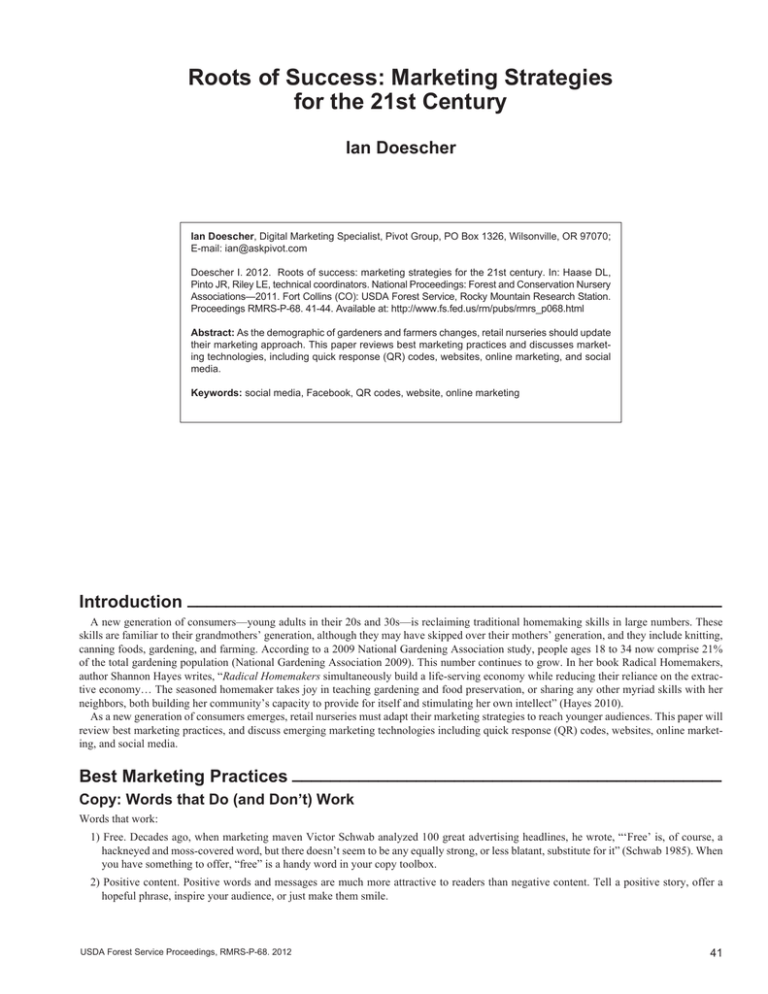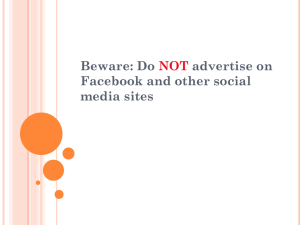Roots of Success: Marketing Strategies for the 21st Century Ian Doescher
advertisement

Roots of Success: Marketing Strategies for the 21st Century Ian Doescher Ian Doescher, Digital Marketing Specialist, Pivot Group, PO Box 1326, Wilsonville, OR 97070; E-mail: ian@askpivot.com Doescher I. 2012. Roots of success: marketing strategies for the 21st century. In: Haase DL, Pinto JR, Riley LE, technical coordinators. National Proceedings: Forest and Conservation Nursery Associations—2011. Fort Collins (CO): USDA Forest Service, Rocky Mountain Research Station. Proceedings RMRS-P-68. 41-44. Available at: http://www.fs.fed.us/rm/pubs/rmrs_p068.html Abstract: As the demographic of gardeners and farmers changes, retail nurseries should update their marketing approach. This paper reviews best marketing practices and discusses marketing technologies, including quick response (QR) codes, websites, online marketing, and social media. Keywords: social media, Facebook, QR codes, website, online marketing Introduction ________________________________________________________ A new generation of consumers—young adults in their 20s and 30s—is reclaiming traditional homemaking skills in large numbers. These skills are familiar to their grandmothers’ generation, although they may have skipped over their mothers’ generation, and they include knitting, canning foods, gardening, and farming. According to a 2009 National Gardening Association study, people ages 18 to 34 now comprise 21% of the total gardening population (National Gardening Association 2009). This number continues to grow. In her book Radical Homemakers, author Shannon Hayes writes, “Radical Homemakers simultaneously build a life-serving economy while reducing their reliance on the extractive economy… The seasoned homemaker takes joy in teaching gardening and food preservation, or sharing any other myriad skills with her neighbors, both building her community’s capacity to provide for itself and stimulating her own intellect” (Hayes 2010). As a new generation of consumers emerges, retail nurseries must adapt their marketing strategies to reach younger audiences. This paper will review best marketing practices, and discuss emerging marketing technologies including quick response (QR) codes, websites, online marketing, and social media. Best Marketing Practices _____________________________________________ Copy: Words that Do (and Don’t) Work Words that work: 1) Free. Decades ago, when marketing maven Victor Schwab analyzed 100 great advertising headlines, he wrote, “‘Free’ is, of course, a hackneyed and moss-covered word, but there doesn’t seem to be any equally strong, or less blatant, substitute for it” (Schwab 1985). When you have something to offer, “free” is a handy word in your copy toolbox. 2) Positive content. Positive words and messages are much more attractive to readers than negative content. Tell a positive story, offer a hopeful phrase, inspire your audience, or just make them smile. USDA Forest Service Proceedings, RMRS-P-68. 2012 41 Doescher 3) How and why. Consumers like finding out the answers to questions, learning new things, and getting an inside scoop. Copy that promises to answer a question—to teach people how to do something, how something works, why something matters, or why they should do something—is a compelling hook. Words that don’t work in marketing copy: 1) Technical language. Industry-specific words may not be the right words for your marketing materials, particularly if they are words that only a few people know. There is no need to talk about embryos, angiosperms, and gymnosperms when you can just as easily talk about seeds. 2) Complicated language. Zarrella (2010) showed that the most popular writing online was written at a ninth grader’s reading level or lower. Even more popular was language written at a second or third grade level (Figure 1). This doesn’t mean consumers are dumb, just that your copy should be simple and to the point. 3) Vague copy. The more specific your content is, the more likely your audience is to read it. For instance, an article on “How to be successful in business” is less compelling than an article on “How to lift your business out of debt.” Your copy should be focused, addressing a specific need or answering a specific question rather than speaking in generalities. Design: What to Remember When Creating Your Ads Following these best practices of design will help you create effective ads and other materials. 1) Make your design clear. If things in your ad look too cluttered to you, they definitely will to potential customers. Don’t feel the need to say everything about your plants, trees, and other products at once. 2) Use white space effectively. The eye needs white space to make sense of content and to process text and images. Instead of trying to use every last bit of your available space, give your design some breathing room by leaving areas of white space in your design. 3) Tell a story. Recent marketing studies show that the most effective ads are those that tell a story. Stories engage viewers’ imaginations and invite them to imagine themselves as part of the story. Remember also that stories aren’t just written text— stories can be told through images. Figure 1. Percentage, above or below average, of Facebook posts that were shared (re-posted) based on reading grade level of the post (modified from Zarella 2010). 42 Roots of Success: Marketing Strategies for the 21st Century 4) Stay true to your brand. Your materials should have a look and feel consistent not only with each other but also with the brand you have established. Remember that your brand is more than your logo or your typical ad colors—your brand is all about how people perceive you. So if you’re the hippest nursery around, your ads should reflect that. If you’re known for being a family business since 1895, your ads should reflect that. 5) Double check your spelling and grammar. At best, spelling and grammar mistakes are embarrassing. At worst, they make your audience think you don’t care—so why should they? Remember that your computer’s spell check doesn’t catch everything, so giving your materials a second glance with an eye toward spelling and grammar is important. Emerging Marketing Strategies _____ Quick Response Codes The first emerging marketing strategy this paper will discuss is QR codes (Figure 2). These codes refer to two-dimensional (rather than traditional one-dimensional) barcodes. Whereas a traditional UPC (Universal Product Code) encodes 10 digits, QR codes are capable of holding over 7,000 numbers or over 4,000 alphanumeric characters. QR codes can encode information like product information, web addresses, and more. UPCs have traditionally only been readable by special scanners (and number nerds). By contrast, QR codes can be read by a QR code scanner or by most cell phones with a camera. Since their introduction, QR codes have been used in marketing campaigns for everything from movies to sporting goods, cell phones to restaurants. QR codes have been printed on posters and in magazines, but also in public places like the sides of buildings. Any cell phone user spotting such a QR code can use their phone to read the code and receive a message, be taken to a website, make a call to a special phone number, and so on. Free online generators allow you to create QR codes capable of performing a number of functions: 1) A QR code that stores an URL (web address) takes the person who reads the code with their smartphone directly to the encoded website; 2) A QR code that stores a phone number automatically places a call to the phone number encoded in the QR code; 3) A QR code that stores text displays the encoded message on the user’s phone; Figure 1. A sample quick response (QR) code. USDA Forest Service Proceedings, RMRS-P-68. 2012 Roots of Success: Marketing Strategies for the 21st Century 4) A QR code that stores a phone number and text message (SMS), sending the encoded text message (up to 160 characters long) to the encoded phone number. QR codes represent great potential for marketing your business and easily attaching information to your products. This technology is growing in popularity and may be a way to bring a quick response to your creativity. Websites In the year 2011, the power and ubiquity of websites is well-known. While most nurseries have websites with fine designs, a website needs frequent refreshing. Listed below are some simple ways to refresh your site: 1) Update news and events. Make sure your online calendar or other list of events is current and highlights future (not past) items. 2) Rewrite copy. Reread the copy you originally wrote for your website and revise as needed. Fresh content on a website helps search engines see that your website is active and well-used; this will improve your search engine rankings. Rewriting copy can also give repeat site visitors a better experience as they find a new message greeting them. 3) Update images. Replacing images on your website that are old or have been on the site for a long time is a simple way to update the look of your site. As a general rule, you should replace any photo older than a year. 4) Link to social media. The home page of your website should feature and link to your social media sites. If possible, integrating social media sites in your internal pages—adding Like or Tweet buttons, for instance—is another way to engage users as they visit your site. Online Marketing Online advertising has become a key piece of most marketing campaigns. Generally, online marketing falls into two categories: social media marketing and search engine marketing. 1) Social media marketing refers to placing ads on social media sites like Facebook. Social media marketing is a powerful tool, because ads can be targeted based on the profiles users have created. Facebook ads are currently the most popular forum for social media marketing, allowing you to target ads to specific people based on location, gender, age, interests, and so on. For example, you can target your ad to people within 10 miles of Smallville whose interests include gardening. Facebook will tell you how large your proposed list is. Then you design your ad and tell Facebook how you want to pay for it—by impressions (number of times your ad is shown) or actual click-throughs (number of times people click and go to your site). You can also automatically limit the amount you spend if desired. LinkedIn© and other social media services offer similar advertising options. 2) Search engine marketing can refer to ensuring your search engine optimization (SEO) is fresh, but it also refers to placing ads with search engines. When you perform a search online, you see sponsored links on the side or the top of the results. Those links are there because those companies paid to be featured as “sponsored” results. This is search engine marketing—paying a search engine to list you as a sponsored link for certain words or phrases. This can be as straightforward as paying Bing™ to list you as a sponsored link for a keyword phrase that describes your company, or as comUSDA Forest Service Proceedings, RMRS-P-68. 2012 Doescher plex as paying search engines to show your ad for keywords that aren’t necessarily related to your company. Both social media marketing and search engine marketing should be an aspect of your marketing campaigns in 2011 and beyond. Social Media The rise of social media services like Twitter and Facebook—that currently have over 800 million users worldwide—has made social media an area marketers should not avoid. Social media sites allow companies to create business profiles, attract “likers” and followers, and spread the company’s message to those people. Following are some of the best practices of social media: 1) Write a social media strategy. Your strategy should answer at least five questions: a) What is our company’s goal for using social media? b) Which sites should we use? c) Who will keep the content fresh? d) Who is our audience for social media? e) How will we promote our social media presence? 2) Avoid using too many social media sites. When you are spread across too many social media sites, it is difficult to have an effective and engaging presence in every place. Instead, focus on one or two sites that will be most useful. Facebook is likely to be one of these sites for two reasons: 1) Facebook’s reach is more extensive than any other social media site; and 2) Facebook enables you to use various types of media and expressions. 3) Keep content engaging and current. Keeping the content on your social media pages fresh is as important as being on social media in the first place: don’t do one without the other. For Facebook, this means posting something daily (at best), or at least once a week. Also, make sure your content is engaging—give your likers and followers a reason to stay connected to you. You can do this by letting your personality show, offering insights and deals exclusive to your social media connections, posting photos and videos, and generally making your page an interesting place to be. 4) Attempting to control the conversation is unacceptable. Most social media sites give people a way to respond to you publicly. People expect to have a voice on social media, even on someone else’s social media page. It may be difficult to read negative comments, and there are various strategies for moderating those, but controlling the conversation is considered unacceptable in the realm of social media. 5) Respond promptly when people comment on your social media site. Make sure your social media sites are monitored regularly so quick responses can be made. The response can often be as simple as, “Thanks for letting us know,” or “We’ll have someone contact you about that as soon as possible,” but do respond quickly. 6) Overselling on social media may be the quickest way to get people to stop liking you or following you. If you are going sell your products or services through social media, consider offering a special deal to your social media connections. Tweeting a special 25% coupon code on your widgets offers more value than simply tweeting, “Did you know we sell widgets?” These social media best practices will help you avoid some common pitfalls. Remember that the ultimate value of social media is in cultivating relationships with your customers and prospects. 43 Doescher Roots of Success: Marketing Strategies for the 21st Century Conclusion ______________________ Updating your marketing approach for the 21st century is vital for nurseries who wish to reach the next generation of gardeners and farmers. Using the best practices and emergent marketing technologies described in this paper, you will see greater marketing success and improved sales. References ______________________ Hayes S. 2010. Radical homemakers: reclaiming domesticity from a consumer culture. Schoharie County (NY): Left to Write Press. 352 p. National Gardening Association. 2009. The impact of home and community gardening in America. URL: http://www.gardenresearch.com/files/2009-Impact-of-Gardening-in-America-WhitePaper.pdf (accessed 20 Feb 2012). Schwab VO.1985. How to write a good advertisement: a short course in copywriting. Chatsworth (CA): Wilshire Book Company. 256 p. Zarrella D. 2010. The science of Facebook marketing. URL: http:// www.slideshare.net/HubSpot/science-of-facebook-marketing-bydan-zarrella (accessed 20 Feb 2012). The content of this paper reflects the views of the authors, who are responsible for the facts and accuracy of the information presented within. 44 USDA Forest Service Proceedings, RMRS-P-68. 2012


